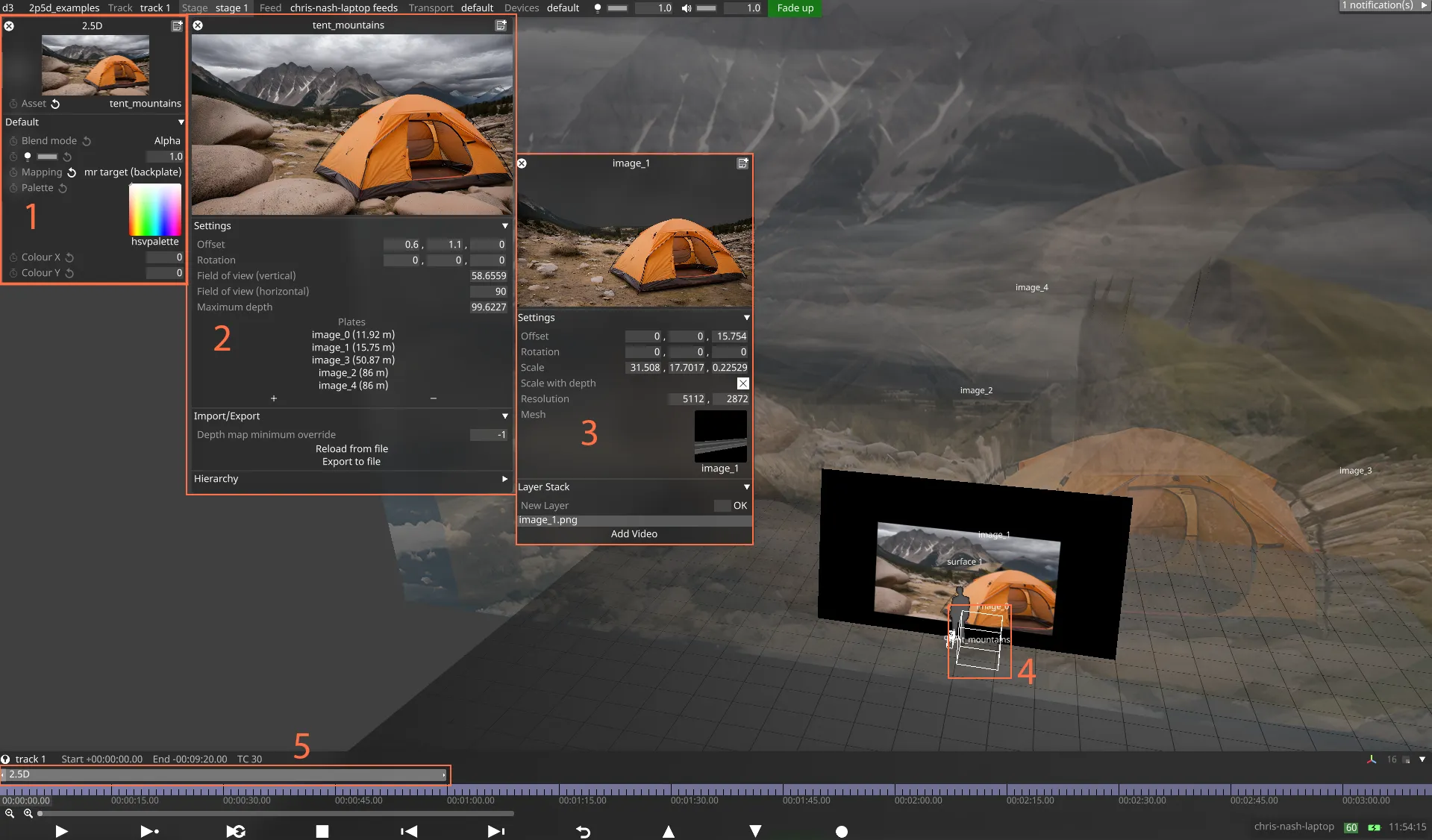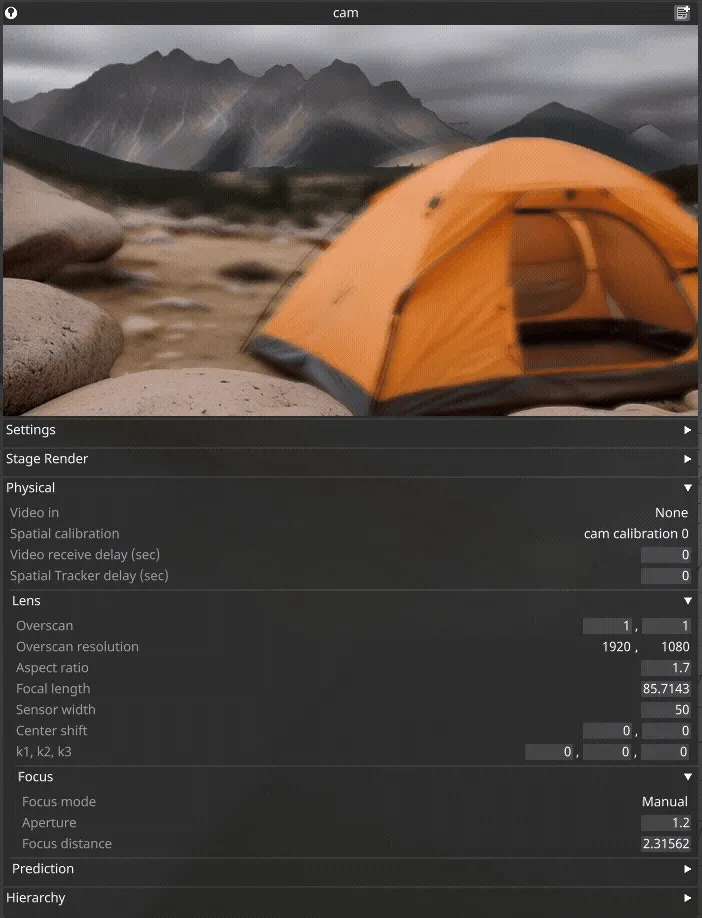2.5D workflow
With Disguise’s 2.5D workflow tools, you can achieve the parallax effect of real-time 3D content with the simplicity of video plates.
What is a 2.5D workflow?
Section titled “What is a 2.5D workflow?”2.5D workflows bridge the gap between traditional 2D video plates and full 3D generative scenes. By building up a scene with layers of images or video plates, with the possibility to add depth or shaping to the plates, users can quickly create a realistic looking scene with parallax. 2.5D assets can be saved as .2p5d files and shared across projects, or created using external integrations such as Cuebric to harness the power of generative AI.
2.5D workflow
Section titled “2.5D workflow”This section details the following how-to guides:
- Set up a 2.5D asset from an existing .2p5D file
- Create a new 2.5D asset from scratch
- Modify 2.5D asset properties
- Modify 2.5D plate properties
- Advanced workflows

- 2.5D Layer editor
- 2.5D Asset selector
- 2.5D Plate editor
- 2.5D Asset origin
- 2.5D Layer
Set up a 2.5D asset from an existing .2p5D file
Section titled “Set up a 2.5D asset from an existing .2p5D file”Use this workflow when receiving assets from Cuebric or another existing project.
- Copy the .2p5d file to objects/2p5DFile in the project folder.
- Add a 2.5D layer to the timeline.
- In the 2.5D layer editor, click on the Asset field. The copied 2p5d file should appear in the list of assets in the 2.5DAsset selector.
- Click on the asset to select it. It will then load and be visible in the stage.
- In the 2.5D layer editor Mapping property, select the desired 3D mapping e.g. MR set backplate.
- To reload the asset from file and overwrite any local changes, click Import/Export & Reload from file in the property editor of the 2.5D asset.
Create a new 2.5D asset from scratch
Section titled “Create a new 2.5D asset from scratch”Use this workflow to build a layered parallax scene directly inside Designer.
- Add a 2.5D layer to the timeline.
- In the 2.5D layer editor, click on the asset field and create a new 2.5D asset.
- Add a new 2.5D plate to the plates field in the 2.5D asset.
- Under Layer Stack in the plate editor, click Add Video to add a video or image to the plate.
- Continue adding plates and modifying their properties until the desired scene composition is achieved.
- Select the desired 3D mapping in the 2.5D layer, e.g. MR set backplate.
- To export the asset for use in other projects, click Export to file under Import/Export in the 2.5D asset editor. The exported .2p5d file will appear under objects/2p5DFile in the project folder.
Modify 2.5D asset properties
Section titled “Modify 2.5D asset properties”The 2.5D asset acts as the “container” for all plates.
-
Origin (asset origin box)
The 2.5D asset is an Object which can have its offset and rotation set by changing the values in the editor, or moving the 2.5D Asset origin (white box) in the visualiser. Doing so will move all the plates and change the origin point of the 2.5D scene. It is recommended that the origin is set roughly in the middle of the range of movement of the camera, to achieve the most realistic looking parallax. -
Field of view & Maximum depth
The Field of view and Maximum depth fields can be adjusted to scale the total area encompassed by the 2.5D scene. This can be used to ensure that the edges of the plates are not seen when moving the camera within its expected range. -
Managing plates
Plates can be added to or removed from the asset using the +/- buttons in the Plates field of the asset editor. Plates are ordered by depth, and reordering the plates in the list will update the plates’ depth to reflect their new positions. -
Import/Export controls
The Import/Export settings can be used to load or save .2p5d files. When loading files which contain depth maps, the Depth map minimum override setting can be used to change the minimum distance from the origin, represented by full white in the depth map. -
Mode: Normal vs Locked
The Mode option allows switching between Normal and Locked mode:- In Normal mode, playback of 2.5D scenes containing video runs independently
- In Locked mode, playback of videos in the plate’s Layer Stack is synchronised to the global track playhead. This ensures the videos in the plate behave like standard video layers and respond consistently to global playback controls and modes.
-
Visibility
Enable Show in stage to make the asset always visible. If it is not enabled (ticked), the asset will be visible only when a relevant editor is open.
Modify 2.5D plate properties
Section titled “Modify 2.5D plate properties”Each plate acts as a layer inside the 2.5D scene.
-
Depth (z)
The plate depth can be changed by modifying the z offset value, or by dragging the plate in the visualiser. If the option Scale with depth is ticked, the scale and x/y offsets will automatically be adjusted with depth so that the plate looks the same when viewed from the asset origin. If Scale with depth is not ticked, the scale and x/y offsets will not change, so the plate will appear smaller as it moves further away. -
Scale & position
By default, new plates will be scaled to match the total field of view of the asset. However, the scale values can be adjusted in the 2.5D plate editor to change the scale. Similarly, the x and y offsets can be adjusted to move the plate position. -
Plate mesh
The plate’s mesh can be modified to introduce depth to a layer, enhancing the realism of the parallax effect. Some .2p5d files will contain depth maps, which are automatically converted into meshes upon import. To remove the depth from the plate, the standard rectangle mesh can be selected instead. It is also possible to add a video depth map using a Depth Map Mesh. -
Layer Stack
The plate Layer Stack is used to set up the layers appearing on the plate. To quickly add an image or video to the plate, use the Add Video button. Otherwise, layers can be created as normal and stacked to create effects such as blur or colour adjust. Note that these layers can’t be keyframed, see Advanced Workflows for methods to keyframe layers on plates.
Apply depth of field to 2.5D assets
Section titled “Apply depth of field to 2.5D assets”You can apply DOF to 2.5D assets on virtual cameras.
Depth of field can be applied to renders of 2.5D assets on camera frontplates and backplates, using the Focus properties in the camera’s Lens settings. See Camera Properties for more information about these settings.
To use lens focus parameters with a 2.5D layer:
- Set up a 2.5D layer as described above.
- Map the layer to a Camera or MR set’s Backplate or Frontplate.
- Set the active camera’s Focus mode to Manual or Object tracking.
- Adjusting the lens focus parameters in the camera should cause the depth of field effect to change in the rendered 2.5D asset.

Advanced workflows
Section titled “Advanced workflows”The 2.5D layer and assets are designed to provide a user-friendly way to quickly create 2.5D scenes which are portable between projects. The standard workflow should allow for the majority of use-cases, however more advanced workflows can also be achieved by combining 2.5D assets with other tools in Designer.
-
Layer stack for quick composition
Generally images, videos and effects should be added to plates using the plate Layer Stack. However, this does not allow for keyframing within these layers. To keyframe content on plates, layers should be added to the timeline as normal. Content can be mapped to 2.5D plates from the timeline similarly to any other display. -
Keyframing via the main timeline
To keyframe plate content (e.g. opacity, transforms, effects), add layers to the timeline instead of the Plate Layer Stack, then map those layers to the plate like any other display. -
Animate assets and plates as Objects*
Both 2.5D assets and plates are full Designer Objects, which means they can be animated on the timeline or parented to tracking-driven objects. -
Legacy Stage Render workflow (pre-r26.3)
The Stage render layer which was used for 2.5D workflows prior to r26.3 still functions as it did previously, so it is still possible to use the original workflow if desired. -
Using video-driven depth on plates
For dynamic depth shaping, set a plate’s mesh to a Depth Map Mesh as the plate’s mesh, and adding a Depth Video Layer to the plate’s layer stack.
Original workflow (available prior to r26.3)
Section titled “Original workflow (available prior to r26.3)”Preserved for historic compatibility.
- Using the stage menu, add an LED surface and a camera to your project.
- Create 3 projection surfaces and position them behind the LED screen incrementally with a gap of several metres between each.
- Label each surface in the composition stack to reflect it’s location. e.g. “foreground’, “midground”, and ‘background”.
- Make the following changes:
- Set foreground and midground surfaces to Transparent
- Set the blend mode for the foreground and midground to Alpha.
- Change the render layer of each surface to Backplate (MR).
- Using the stage menu, create an MRset.
- Assign the LED screen to the MRset and change the Camera property to Camera override.
- Add a StageRender layer to the timeline above the other content layers and map it to the backplate.
- Move the camera within the MRset to activate it.
- The perspective projection will appear on the LED screen and tracks the movement of the camera.